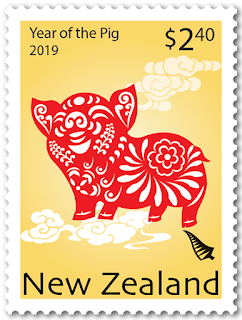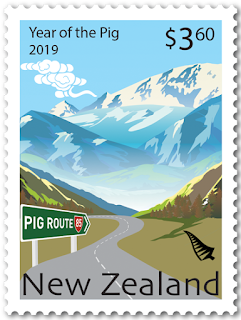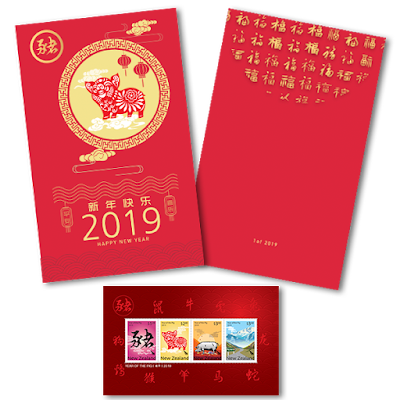2019 The Year of the Pig.
People born in the Year of the Pig tend to be straightforward, kind-hearted and generous. They enjoy spending time and sharing things with others, although their openminded, trusting, fun-loving attitude and tendency to say ‘yes’ can leave them open to being taken advantage of. While Pigs are generally relaxed, easy on themselves and often romantic, they’re also straight-talkers with a strong and earnest sense of justice. They approach tasks assigned to them with energy and perseverance and complete them to the best of their abilities. They can be trusted to do a good job. In tough times though, Pigs can become emotional, spiral into a negative state of mind and lose all motivation. They can also be prone to judging others – a characteristic that can get them into trouble.
The Stamps.
$1.20 - Calligraphy.
Calligraphy (hanzi) is a unique art form that for centuries has been a key part of Chinese culture, traditions and everyday life. Today, couplet-writing and calligraphy continue to have an essential role in Chinese New Year celebrations, and this year they feature in the design of the $1.20 Year of the Pig stamp.
$2.40 - Paper-Cutting.
Paper-cutting (jianzhi) is a 1,500-year-old form of Chinese folk-art in which the people and animals of folktales and legends are recreated in a huge variety of shapes, sizes and colours. Paper-cut animals of the Chinese zodiac are popular features at Chinese New Year when they’re used for decoration and as gifts for family and friends visiting from afar.
$3.00 - The Pig.
The origins of the rare Arapawa pig are clouded in mystery, but it’s said that explorer Captain James Cook introduced them to New Zealand’s Arapaoa Island (in the Marlborough Sounds) when he visited almost 250 years ago. This stamp connects New Zealand to China and Chinese New Year with an Arapawa pig depicted in line art.
$3.60 - State Highway 85 (Pig Route).
State Highway 85, in the South Island of New Zealand, is also known as the ‘Pig Route’. One of the popular stories behind the name dates back to the gold rush of the 1880s when, it’s said, wild pigs would approach the miners’ horses and rub noses with them. Today, the highway is the main route from Alexandra to Central Otago.
Collectables.
First Day Cover - 16 January 2019.
The 2019 Year of the Pig Miniature Sheet.
Notice the sign for each of the 12 signs of the zodiac with the Year of the Pig being circled in the top-left corner.
Miniature Sheet First Day Cover - 16 January 2019.
The 2019 Year of the Pig Presentation Pack.
This informative presentation pack provides some background detail to the Chinese lunar calendar, as well as elaborating on the characteristics of someone born in the year of the pig.
The 2019 Year of the Pig Lucky Red Envelope.
Alongside this year's Chinese New Year stamp issue, 2,019 individually numbered lucky red envelopes will be available. These envelopes each contain one 2019 Year of the Pig miniature sheet. They are intended to bring good luck to the recipient.
The 2019 Year of the Pig Framed and Numbered Gold Foiled Miniature Sheet.
This large miniature sheet is one of only 103 produced so you'll need to order quickly! It has been embossed and etched with micro-fine detail from 24-carat 99.9 gold foil and is presented within an individually numbered frame (measuring 39cm x 27cm).
The 2019 Year of the Pig Gold Plated Medallion.
This limited edition, gold-plated medallion features the calligraphic character for ‘pig’ on one side and an illustrated paper-cut pig as seen on the $2.40 stamp, on the other side. This collectable medallion is limited to only 999 worldwide and comes with an individually numbered certificate that gives further context and background to the Chinese Year of the pig. It is presented in a specially designed case and makes a beautiful gift for anyone born in the Year of the Pig.
2007 - The Year of the Pig.
Although not native to New Zealand, pigs have been part of our landscape for more than 200 years. In 1769, French explorer Jean Francois-Marie de Surville gave two piglets to a Māori chief, and within five years English navigator James Cook had brought more to our shores. Since then, pigs have become more than just livestock – for many Kiwis, they are family pets.
The Stamps.
This stamp issue is a celebration of the Chinese Year of the Pig in 2007. The Stamps show three pigs that New Zealand is proud to call its own. All three are remnants of earlier introductions that have, through isolation, developed unique qualities and characteristics – and along the way, gained enthusiastic support that has ensured their survival in a world where commercial production considerations would have ended their continued existence.
The Stamps.
This stamp issue is a celebration of the Chinese Year of the Pig in 2007. The Stamps show three pigs that New Zealand is proud to call its own. All three are remnants of earlier introductions that have, through isolation, developed unique qualities and characteristics – and along the way, gained enthusiastic support that has ensured their survival in a world where commercial production considerations would have ended their continued existence.
45c - Kunekune Piglet.
The endearingly cute kunekune (the Māori word for ‘plump’) is the most popular of New Zealand’s non-commercial pig breeds. With its round, pot-bellied body, short legs, upturned snout and lower-jaw ‘tassels’, it has a wonderfully comical appearance – and its placid and intelligent nature, combined with a passion for food and a good scratch, make it an adorable and adored pet.
90c - Kunekune Pig.
Kunekune pigs, which are almost certainly of Asian origin, were probably introduced to New Zealand by whalers or traders very early in European settlement times. In 1984, 18 were collected to become part of a captive breeding programme, and most of the kunekune found in New Zealand today are their descendants. Kunekune have also been exported to proud owners in the United Kingdom, the United States and Europe.
$1.35 - Arapawa Pig.
No one really knows the exact origin of how the feral pigs of Arapawa Island (in the Marlborough Sounds) got there, but it has been suggested that they are descendents of animals released in the area by James Cook 1773 and 1777. Once critically endangered, they are now protected by the Arapawa Wildlife Sanctuary, a 120-hectare park that’s home to about 100 globally endangered animals. However, there are thought to be no more than 100 Arapawa pigs both on and off the Island, so the survival of this rare breed is by no means assured.
$1.50 - Auckland Island Pig.
Pigs were introduced to Auckland Island (more than 300 kilometres south of New Zealand) in 1807 as a source of food for whalers and shipwrecked sailors. Subsequent introductions led to a thriving population, which in the 1990s came under threat through a Department of Conservation extermination programme. Seventeen were rescued and brought back to the mainland where, thanks to a selective breeding programme, their future is looking bright.
$2.00 - Ruby / Champion Junior Sow.
The kunekune pig featured on the $2.00 stamp is Ruby, the Champion Junior Sow of the 2005 Canterbury A&P Show. Just five months old when this photograph was taken, she already displayed the typical kunekune colouring, with shades of brown, black and cream. The texture of the coat changes with the season, often becoming thicker and longer in winter.
Collectable Items.
First Day Cover - 7 February 2007.
Miniature Sheet with one $1.50 and one $2.00 stamp.
Miniature Sheet First Day Cover - 7 February 2007.
Limited Edition.
Limited edition collectable containing exclusive stamp products not available anywhere else.
Limited Edition Miniature Sheet with one 90c and one $1.35 stamp (2,000 numbered copies).
Presentation Pack.
Presentation pack containing a selection of stamp products from the issue and further information on the theme of the stamps.
Enlargement of the Presentation Pack Cover.
We can see more detail of this clever series of artworks the extended through 12 years of Chinese New Year. Each year the image of the current animal appeared in the colour centre while all the other images, just in black, can be seen around the circle.
Technical information - 2019.
Date of issue: 16 January 2019.
The Number of stamps: Four gummed stamps.
Denominations: $1.20, $2.40, $3.00, $3.60.
Stamps, miniature sheet and first day covers designed: Asiaworks, Auckland, New Zealand.
Printer and process: Cartor Security Printing, France, by offset lithography.
The number of colours: Four process colours.
Stamp size and format: 30mm x 40mm (vertical).
Paper Type: Tullis Russell 104gsm red phosphor gummed stamp paper
The number of stamps per sheet: 25.
Perforation gauge: 13 x 13.25.
Period of sale: Unless stocks are exhausted earlier, these stamps will remain on sale until 15 January 2020.
First-day covers will remain on sale until 12 March 2019.
First-day covers will remain on sale until 12 March 2019.
Technical Information - 2007.
Date of issue: 7 February 2007.
The number of stamps: Five gummed stamps.
Denominations and designs: 45c, 90c, $1.35, $1.50, $2.00.
Stamps and first-day cover designed: Cue Design, Wellington.
Lunar illustrator: Lindy Fisher, Auckland, New Zealand.
Printer and process: Australia Post, Sprintpak, by offset lithography.
The number of colours: Four process colours.
Stamp size and format: 40.28mm x 30mm (horizontal).
Paper Type: Tullis Russell Helecon 3336 phosphor stamp paper.
The number of stamps per sheet: 25.
Perforation gauge: 14 x 14.4.
Period of sale: These stamps remained on sale until 6 February 2008.
Some of the images in this post were used with permission from the illustrated catalogue of StampsNZ
You can visit their website and Online Catalogue at, http://stampsnz.com/
Information & images for this post came from.























Another Chinese New Year post. It's becoming a large collection now. I collect stamps with this theme from many countries and this blog is a good study for the New Zealand issues.
ReplyDeleteRon Lim
We appreciate your engagement with our content. To ensure a respectful and constructive community, please take note of the following:
- No Spam, Please: We do not tolerate spammy or promotional comments. Any such comments will be promptly removed.
- Moderation in Place: All comments are moderated to maintain a positive and inclusive environment. Please be patient, as it may take a little time for your comment to appear.
- Sign In with Google: To comment, please sign in using your Google account. This helps us maintain the integrity of our community and allows for better interaction.